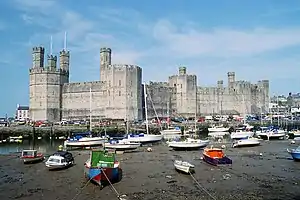
An urban castle (German: Stadtburg) is a castle that is located within a medieval town or city or is integrated into its fortifications.
In most cases, the town or city grew up around or alongside the castle (for example in Halle, Brunswick and Prague), or the castle was built in order to reinforce the defences within or as part of the line of fortification ringing the settlement as, for example, at Erfurt.
Definitions
Creighton draws a distinction between the 'urban castle', where the castle is built in or onto an existing town, and the 'castle borough', "where a primary castle attracts a secondary borough or the two are planned together,"[1] although he acknowledges that the division between the two is not always clear-cut.
Instrument of sovereign power
The urban castle was also used as an instrument of power, for example by William the Conqueror in Norman England,[2] or by territorial lords in the Holy Roman Empire when towns in the late Middle Ages were increasingly striving for their independence. In such cases the urban castle was integrated into a strategically favourable point in the city wall so that the lord could enter the castle from the fields outside unhindered by the citizens and, through another gateway in the castle walls facing the city, could leave the castle and enter the city.
Examples
Austria
- Krems in Lower Austria, has the Gozzoburg, a high mediaeval urban castle.
Czech Republic
Germany
There are examples of urban castles in:
- Andernach in Rhineland-Palatinate where the Electoral Cologne Stadtburg (designed as a water castle) as an instrument of power
- Erfurt with its Petersberg Citadel, which is integrated into the defensive system of the old fortified city
- Esslingen am Neckar: the original outposts on the Schönenberg were gradually incorporated into the town fortifications through the construction of branching walls (Schenkelmauern). Due to the geological situation there, the cost was very high.
- Feuchtwangen in Bavaria still has, in the remains of its town walls, a picturesque link to the site of Little Ottingen Castle (Öttingischen Schlösschen), a former water castle, which juts out from the otherwise circular town wall. Later a small hunting lodge was built on the site
- Friedberg in Hesse has an imperial castle
- Horn-Bad Meinberg in North Rhine-Westphalia has Horn Castle, a castle built into the town's defences
- Nuremberg: the double castle is incorporated into the city wall
- Schlitz in Hesse, one of the best-known examples of urban castles in Germany with four castles.
- Warburg has Wartberch Castle.
- Weißenstein with the old castle of Schloss Weißenstein
Ethiopia
- Emperor Fasilides' Castle (part of the Fasil Ghebbi complex) in Gondar
Finland
Hungary
- Buda Castle in Budapest
- Sárospatak Castle in Sárospatak
Poland
- Wawel Castle in Kraków (part of the Wawel fortified complex of the Kraków Old Town)
Romania
- Brașov Old Town Fortress, Brașov
Slovakia

- Bratislava Castle in Bratislava (fortified site history preceding adjacent city)
- Trenčín Castle in Trenčín
- Nitra Castle in Nitra (parallel evolution of the castle and the city since the early Middle Ages)
- Old Castle (Starý zámok) in Banská Štiavnica (secondary Old Town development, late Middle Ages)
- New Castle (Nový zámok) in Banská Štiavnica (secondary Old Town development, Renaissance)
- Kremnica Castle in Kremnica (secondary Old Town development, late Middle Ages)
- Podolínec Castle in Podolínec
- Kežmarok Castle in Kežmarok
Ukraine
- Uzhorod Castle in Uzhorod
United Kingdom
The Tower of London has been called "the most complete of urban castles",[3] and an "archetypally oppressive castle."[4] Other examples include:
Gallery
.jpg.webp) London, United Kingdom
London, United Kingdom Caernarfon, United Kingdom
Caernarfon, United Kingdom Edinburgh, United Kingdom
Edinburgh, United Kingdom Nuremberg, Germany
Nuremberg, Germany Schlitz, Germany
Schlitz, Germany_Schloss_vom_Adolfsturm.jpg.webp) Friedberg, Germany
Friedberg, Germany.jpg.webp) Balzers, Liechtenstein
Balzers, Liechtenstein_-_Burgruine_mit_Kirche.JPG.webp) Krems an der Donau, Austria
Krems an der Donau, Austria Prague, Czech Republic
Prague, Czech Republic.jpg.webp) Kraków, Poland
Kraków, Poland Budapest, Hungary
Budapest, Hungary Sárospatak, Hungary
Sárospatak, Hungary Kremnica, Slovakia
Kremnica, Slovakia Starý zámok, Banská Štiavnica, Slovakia
Starý zámok, Banská Štiavnica, Slovakia Nový zámok, Banská Štiavnica, Slovakia
Nový zámok, Banská Štiavnica, Slovakia Uzhorod, Ukraine
Uzhorod, Ukraine Brașov, Romania
Brașov, Romania Turku, Finland
Turku, Finland Gondar, Ethiopia
Gondar, Ethiopia
References
External links
- Creighton, O.H. Castles and Landscapes: Power, Community and Fortification in Medieval England. London: Equinox, 2002. ISBN 1-904768-67-9.
- Pounds, N.J.G. The Medieval Castle in England and Wales: A social and political history. Cambridge: CUP, 1994. ISBN 1-903153-61-1.
- Wheatley, Abigail. "The Urban Castle" in The Idea of the Castle in Medieval England, York: York Medieval Press, 2004. pp. 44–77. ISBN 978-1-903153-14-7.